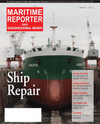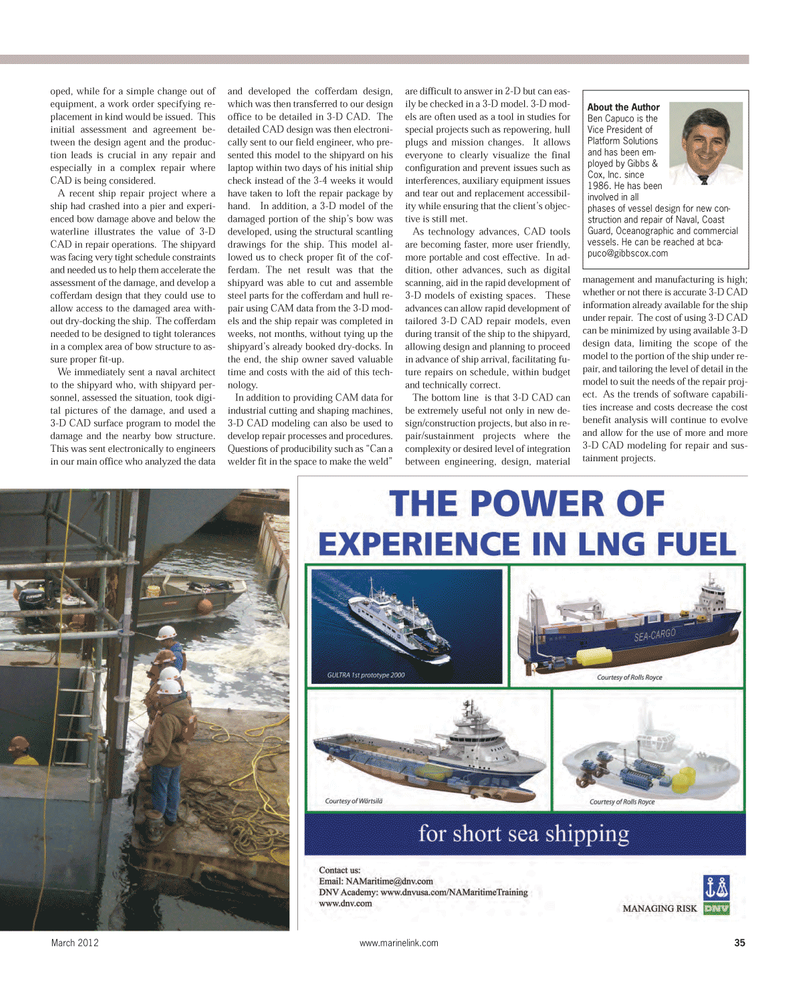
Page 35: of Maritime Reporter Magazine (March 2012)
The Ship Repair Edition
Read this page in Pdf, Flash or Html5 edition of March 2012 Maritime Reporter Magazine
March 2012 www.marinelink.com 35oped, while for a simple change out ofequipment, a work order specifying re- placement in kind would be issued. This initial assessment and agreement be-tween the design agent and the produc-tion leads is crucial in any repair and especially in a complex repair where CAD is being considered.A recent ship repair project where aship had crashed into a pier and experi- enced bow damage above and below the waterline illustrates the value of 3-D CAD in repair operations. The shipyard was facing very tight schedule constraints and needed us to help them accelerate theassessment of the damage, and develop a cofferdam design that they could use to allow access to the damaged area with- out dry-docking the ship. The cofferdam needed to be designed to tight tolerancesin a complex area of bow structure to as- sure proper fit-up. We immediately sent a naval architect to the shipyard who, with shipyard per- sonnel, assessed the situation, took digi-tal pictures of the damage, and used a3-D CAD surface program to model the damage and the nearby bow structure. This was sent electronically to engineers in our main office who analyzed the data and developed the cofferdam design, which was then transferred to our design office to be detailed in 3-D CAD. The detailed CAD design was then electroni- cally sent to our field engineer, who pre- sented this model to the shipyard on his laptop within two days of his initial ship check instead of the 3-4 weeks it would have taken to loft the repair package by hand. In addition, a 3-D model of thedamaged portion of the ship?s bow was developed, using the structural scantling drawings for the ship. This model al- lowed us to check proper fit of the cof- ferdam. The net result was that the shipyard was able to cut and assemble steel parts for the cofferdam and hull re- pair using CAM data from the 3-D mod-els and the ship repair was completed in weeks, not months, without tying up theshipyard?s already booked dry-docks. In the end, the ship owner saved valuable time and costs with the aid of this tech-nology. In addition to providing CAM data for industrial cutting and shaping machines,3-D CAD modeling can also be used todevelop repair processes and procedures. Questions of producibility such as ?Can awelder fit in the space to make the weld? are difficult to answer in 2-D but can eas- ily be checked in a 3-D model. 3-D mod- els are often used as a tool in studies forspecial projects such as repowering, hull plugs and mission changes. It allows everyone to clearly visualize the final configuration and prevent issues such as interferences, auxiliary equipment issuesand tear out and replacement accessibil-ity while ensuring that the client?s objec- tive is still met. As technology advances, CAD tools are becoming faster, more user friendly, more portable and cost effective. In ad- dition, other advances, such as digital scanning, aid in the rapid development of 3-D models of existing spaces. These advances can allow rapid development of tailored 3-D CAD repair models, even during transit of the ship to the shipyard, allowing design and planning to proceed in advance of ship arrival, facilitating fu- ture repairs on schedule, within budget and technically correct. The bottom line is that 3-D CAD canbe extremely useful not only in new de- sign/construction projects, but also in re- pair/sustainment projects where thecomplexity or desired level of integration between engineering, design, materialmanagement and manufacturing is high; whether or not there is accurate 3-D CADinformation already available for the ship under repair. The cost of using 3-D CAD can be minimized by using available 3-D design data, limiting the scope of themodel to the portion of the ship under re-pair, and tailoring the level of detail in the model to suit the needs of the repair proj-ect. As the trends of software capabili- ties increase and costs decrease the costbenefit analysis will continue to evolve and allow for the use of more and more 3-D CAD modeling for repair and sus-tainment projects.About the AuthorBen Capuco is theVice President of Platform Solutionsand has been em-ployed by Gibbs &Cox, Inc. since1986. He has beeninvolved in allphases of vessel design for new con-struction and repair of Naval, Coast Guard, Oceanographic and commercial vessels. He can be reached at bca- [email protected] March 12 # 5 (33-40):MR Template 3/2/2012 8:25 AM Page 35

 34
34

 36
36
